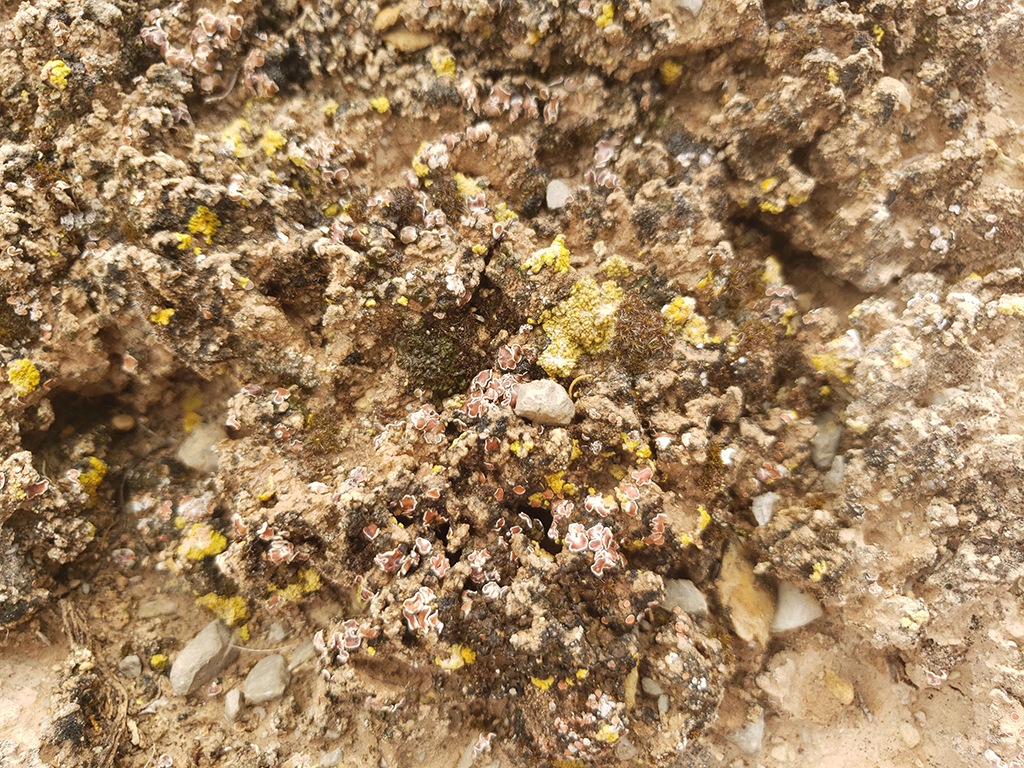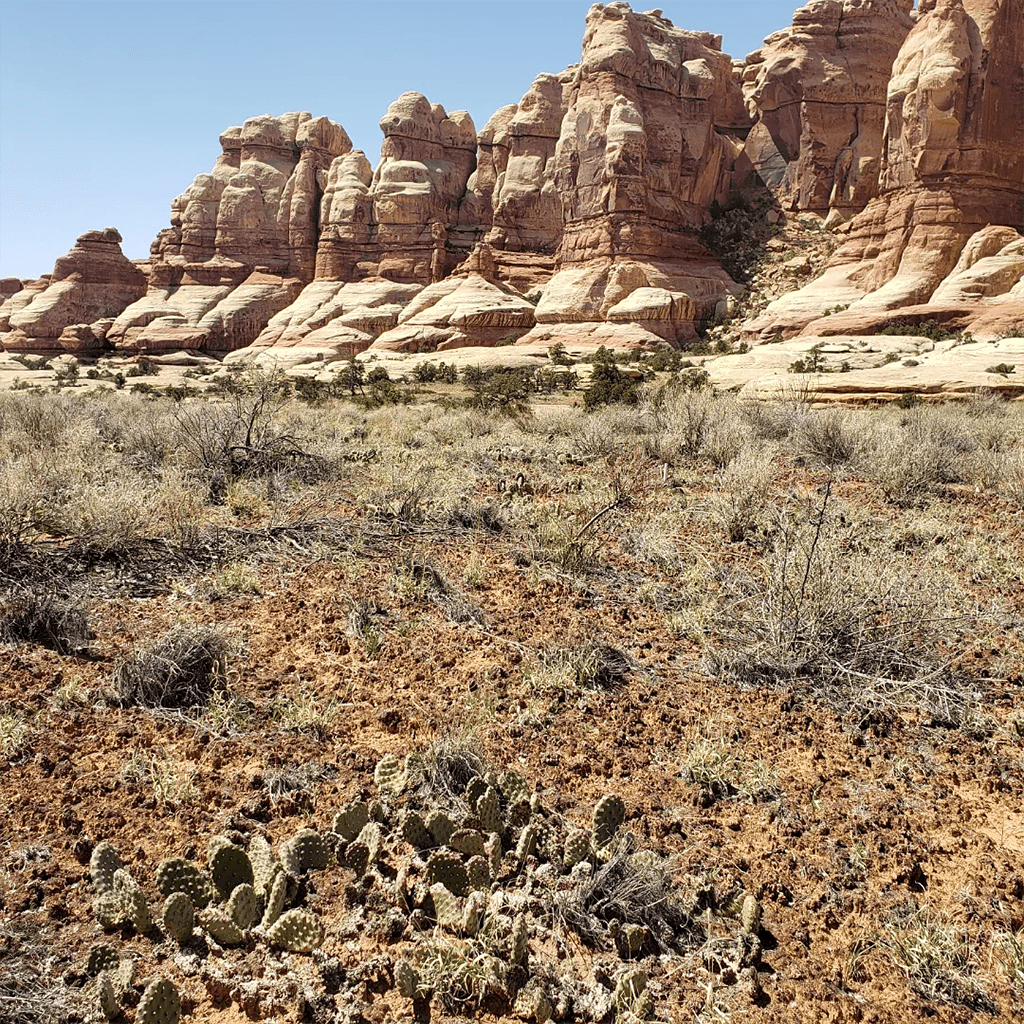Pink stone arches, towers and cliffs appear to puncture the countless blue skies round Moab, Utah. However for Rebecca Finger-Higgens, one other, a lot smaller, the panorama is particularly stunning—the bumpy, lichen- and moss-encrusted prime layer of the soil. That is biocrust.
This layer, lower than an inch thick, is way more than simply dust: It is a group of “actually complicated, stunning organisms,” explains Finger-Higgens, an ecologist with the US Geological Survey (USGS). The mosses in biocrust might seem darkish brown at first, however will gentle up like little inexperienced stars if you drop water on them. Biocrusts additionally sometimes embody lichens ranging in colour from black to pink to yellow. “They’re sort of like these mini mountain ranges—sort of like coral reefs of the desert,” she continues.
Important to supporting ecosystems, these mini mountain ranges span past the Colorado Plateau, throughout the arid lands of the American West and are present in all dry areas of the world. Whereas they’re remarkably resilient to drought, warmth and the forces of wind and water, soil biocrusts are susceptible to the impacts of hooves, human toes and tires. These forces can crush them, breaking up the tight community of organisms and resulting in their hunger. In the event that they handle to get better in any respect, full restoration can take lots of of years.
That is why, in locations like Moab, scientists and advocates are attempting to stop biocrust loss. Even stopping a single stray footstep makes a distinction.

Biocrusts: Enigmatic however Important
What even are these tiny marvels? They seem to be a colony of tiny organisms, most of that are microbial. Biocrusts usually embody micro organism, fungi, lichens and mosses, though the people making up the group range relying on their environment.
The organisms work collectively to outlive of their often-harsh surroundings. Mosses are photosynthesizers, making sugar to feed the biocrust, and lichens—they themselves are a partnership between a fungus and a microbe—get hold of nitrogen from the water. Sure micro organism create filaments that stick the soil floor collectivelynearly like a skinny material coating the bottom.
Soil crusts are discovered on each continent and are linked by a standard goal: stabilizing the soil.
Significantly in arid areas, the place plant protection tends to be patchier, biocrusts carpet the naked soil, defending it from the ravages of wind and water. The truth is, most deserts—together with these of the American West—will not be inherently dusty locations, regardless of how they’re usually depicted in motion pictures and TV, explains Dr. Jayne Belnap, a USGS ecologist who’s been learning soil crusts for the previous 30 years. Moderately, mud storms are likely to kind the place biocrusts have been busted by grazing, use army or different disturbances, leaving free and uncovered soil that flies away when windy.
This stabilizing operate can also be essential as a result of desert soil types at an excruciatingly gradual tempo: It may well take a century for a single centimeter of soil to kind, explains Dr. Belnap. In the meantime, an entire meter of soil could be misplaced when a ferocious windstorm bears down on the uncovered floor. The highest few centimeters of the bottom, together with the biocrusts and the soil instantly beneath them, maintain the vitamins and sponge up the water wanted for crops. “Whenever you watch the mud cloud go by otherwise you watch the flash flood go by, what you are seeing is the productiveness of that ecosystem,” mentioned Belnap.
Past serving because the pores and skin of the desert, biocrusts additionally add vitamins to the soil. Nitrogen, for instance, types the spine of DNA and is a constructing block of proteins—and it is also significantly onerous to return by in arid lands. Microbes referred to as cyanobacteria that’s a part of the lichens in soil crusts can rework nitrogen within the water right into a nutrient that crops can use to help photosynthesis.
Biocrusts themselves additionally photosynthesize, capturing carbon from the ambiance and incorporating it into their biomass and the soil. Among the lichens in biocrusts even produce particular pigments that function sunscreendefending the organisms from dangerous UV rays.
Biocrusts are typically fairly hardy, capable of survive on only a few inches of rainfall per 12 months. They endured scorching and dry months by getting into a dormant state; when rain does fall, the moss on the crusts’ floor blinks awake, turning inexperienced because it begins to photosynthesizemaking sufficient sugar to final the group by one other dry stretch.
The Risk Posed by Desert Recreation
Drought and excessive warmth are usually no downside for biocrusts (regardless of rising summer season temperatures might pose a menace to some), however they do have archnemeses: hooves, heavy automobiles and, more and more, climbing boots.
In recent times, an increasing number of guests have flocked to Moab, Utah’s pink landscapes. Final 12 months, visits to the area clocked in at greater than 3 million. The crowds generally encourage vacationers to drive and trek past the bounds of established trails and campgrounds. In areas administered by the Bureau of Land Administration, similar to alongside Willow Springs Street, issues have been particularly unhealthy: Finger-Higgens says folks there have been parking automobiles exterior the bounds of present roads and campgrounds, bringing in fireplace rings and abandoning their poop, and within the course of driving and stomping over biocrusts.
And soil crusts could be misplaced even with out direct impression. Throughout building of the campgrounds and trails at Sand Flats Recreation Space within the Nineteen Nineties, the ensuing pink mud coated elements of the encircling space, says Belnap. This mud prevented the biocrusts under from absorbing daylight, main them to primarily starve. Pink mud from disturbed Moab soils has even been discovered speckling the snow greater than 400 miles away within the Rocky Mountains, says Kristina Younger, government director of Science Moab, a brand new nonprofit devoted to creating place-based science throughout the Colorado Plateau accessible to the larger public. Because it’s darker in colour than snow, the mud absorbs extra warmth and might trigger accelerated snowmelt, which might create harmful flooding circumstances.
As soon as a panorama is devoid of crusts, it is onerous for them to construct up once more, particularly if the soil has been compacted from repeated travels. In former army coaching grounds within the Mojave, Belnap has noticed minimal crust restoration even after 50 years—and he or she estimates it may take lots of of years for the communities to return again.

Strolling Calmly to Shield Biocrusts
Up to now, scientists’ efforts to regrow biocrusts have had blended outcomes at finest: Whereas it is comparatively simple to develop them in a lab, it is onerous to get biocrusts to take maintain within the wild, says Belnap. Since they’re so onerous to revive, it is necessary to keep away from crushing crusts within the first place. “It is fairly clear to me that you simply simply cannot wreck them.” That is why scientists are working to teach guests on these exceptional teams of organisms and hopefully stop additional loss.
Belnap has led instructional efforts because the ’80s: Whereas guests may not have any concept what biocrust is once they arrive on the trailhead, they have been extremely receptive when given info, both on flyers or posted indicators. Belnap has even squeezed in instructional supplies on the town, similar to at native bike outlets.
Sadly, such efforts require a gentle stream of funding, and park budgets have stagnated, says Belnap. “We had been way more efficient when there was much more cash round,” she mentioned.
In recent times, nonetheless, new crust safety efforts have sprouted. A few of Grand County, Utah’s tourism income is diverted to its path ambassador programlaunched in 2021: County educators, educated by Science Moab employees, arrange at trailheads with a pattern of biocrust in hand, prepared to tell guests concerning the delicate soil communities.
Along with working with the path ambassadors, the Science Moab staff additionally leads science coaching for information corporations, together with these main mountain biking, climbing, rafting and overland excursions.
“There’s this actually cool science that claims if you’re having an journey or an out of doors expertise that is new to you and is a enjoyable expertise, that you’re capable of retain info higher,” says Kristina Younger, Science Moab’s founder and government director. She says guides can function a conduit for info on defending the desert. “I simply have little question that it’s making an impression.”
As for what desert-bound adventurers can do to guard these complicated microorganism communities, soil scientists say that step one is to easily marvel at soil crusts if you encounter them. Get shut sufficient to view them from a rock or the path—simply bear in mind to step rigorously. “Take a minute and go searching and see, possibly you may discover some pinks and yellows, and people little stunning options of the panorama,” says Finger-Higgens.
When you’re executed admiring them, keep on established trails, roads and in present campgrounds. In areas the place restrooms are unavailable, it may be higher to pack out strong waste and paper utilizing a waste bag than climbing off the path and digging a cat gap. If it’s worthwhile to stray past the path or campsite bounds, hop between rocks, logs and the bottoms of washes as a substitute of touching down on the soil. Even when the soil is not bumpy and darkish, there might be less-developed soil crusts current. In drier deserts, just like the Mojave, soil crusts are sometimes almost invisible.
“The crops and animals and biocrusts listed here are all tailored to stay in these harsh circumstances, which implies that they’re delicate to alter as a result of they are surely on this slim zone of the place they will survive,” says Finger-Higgins. “So it is necessary to respect that and to essentially contemplate the place you are going.” Only a few additional precautions can enable the biocrusts—and the ecosystems they help—to proceed thriving, stopping the desert from changing into dusty and barren.


